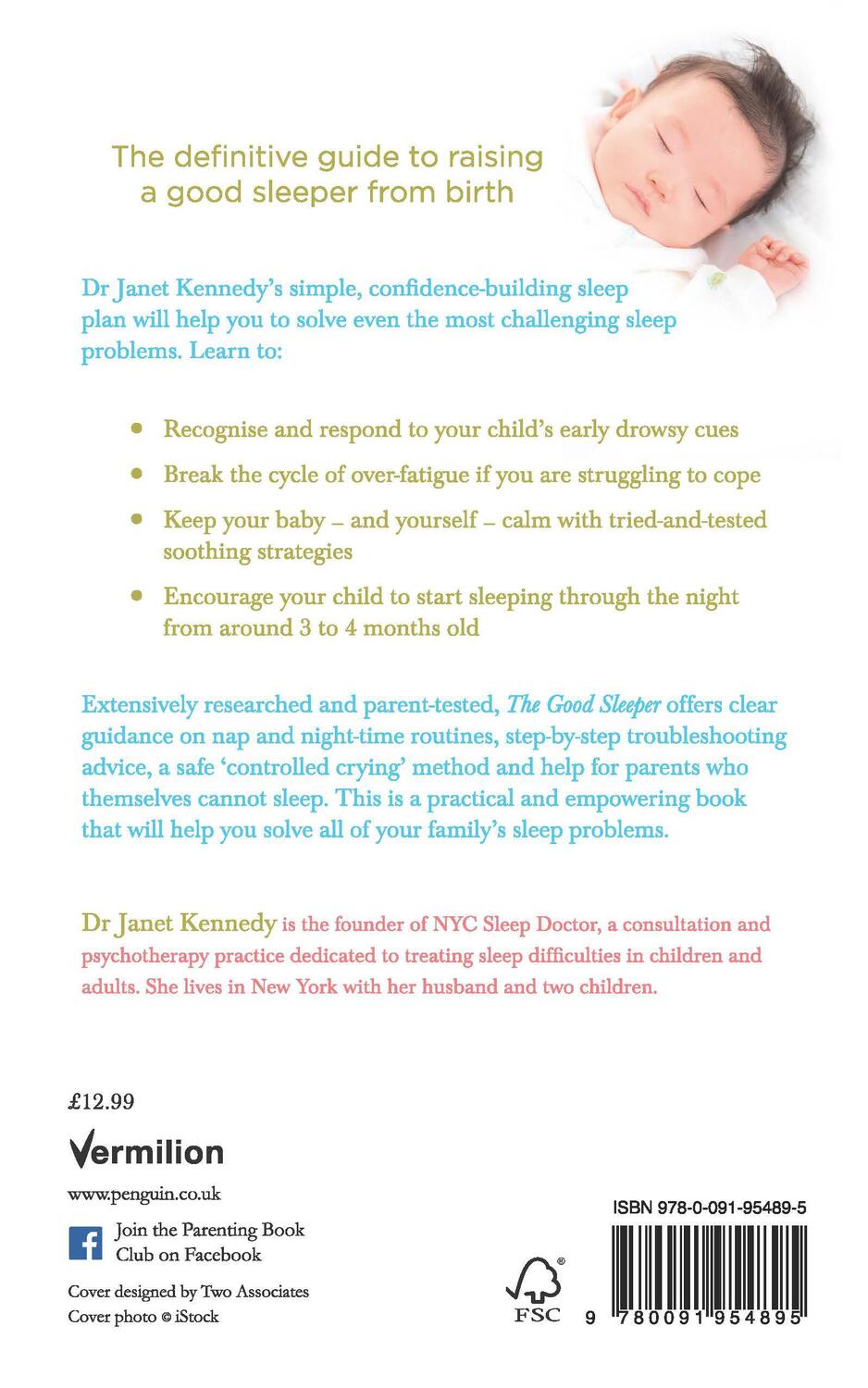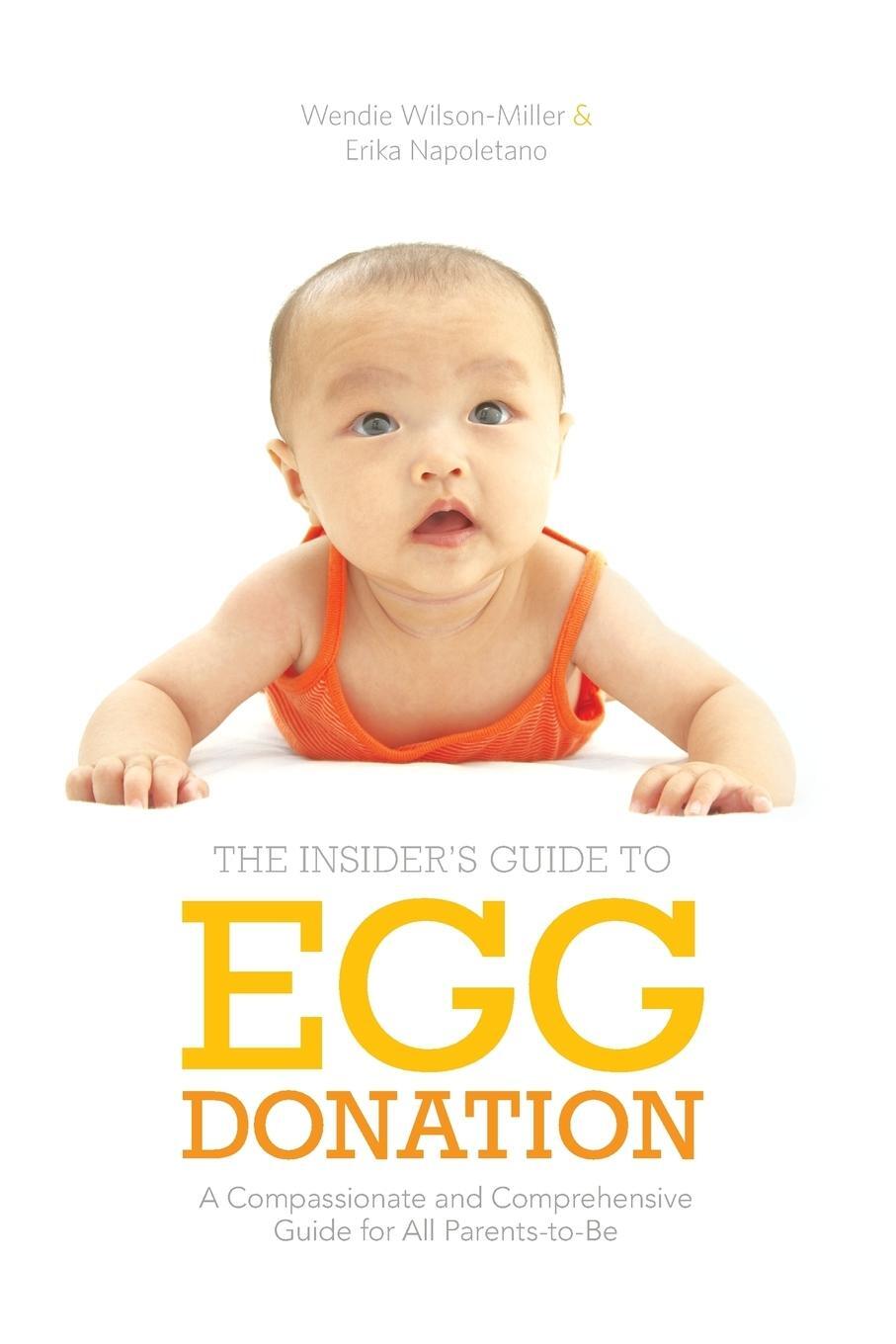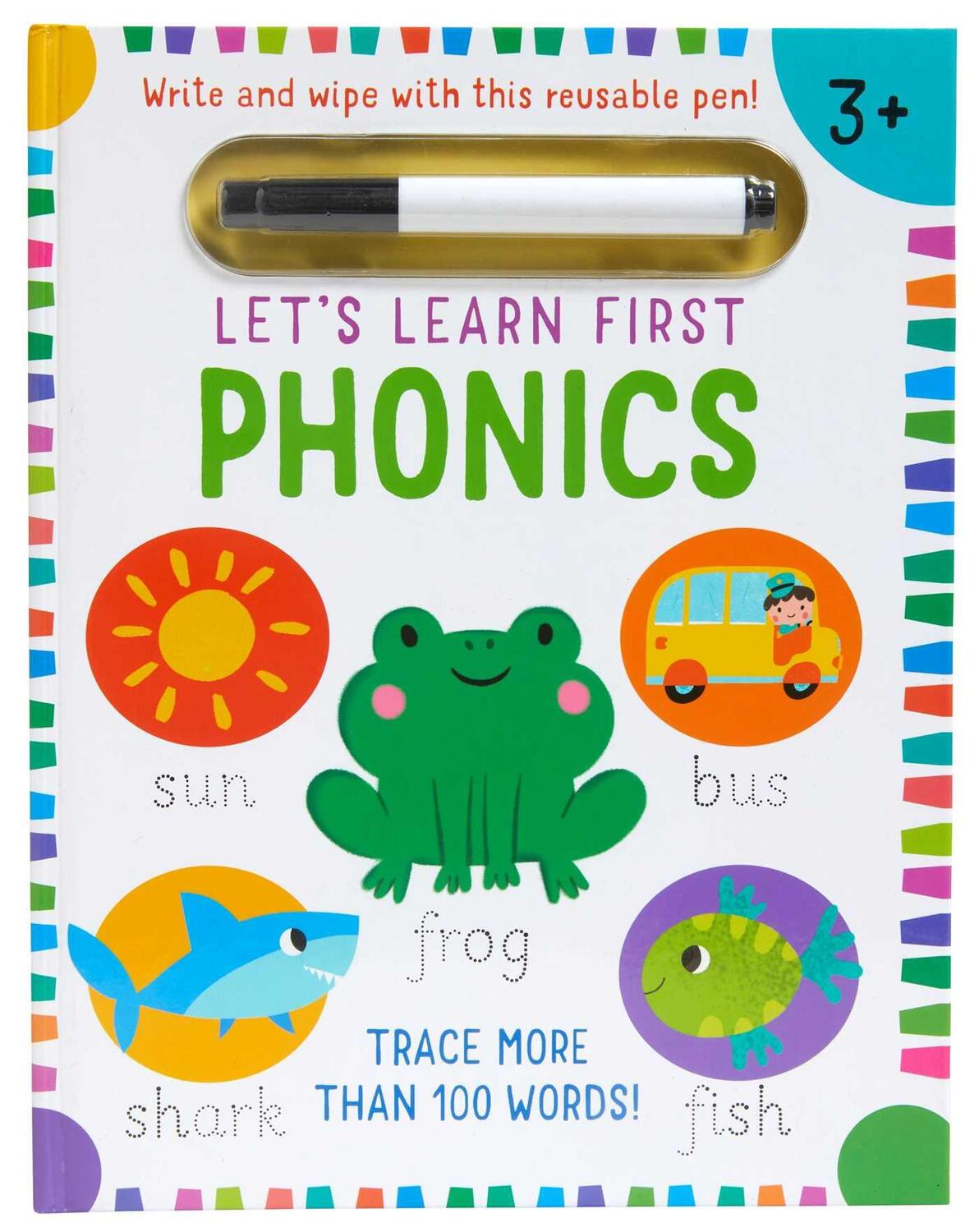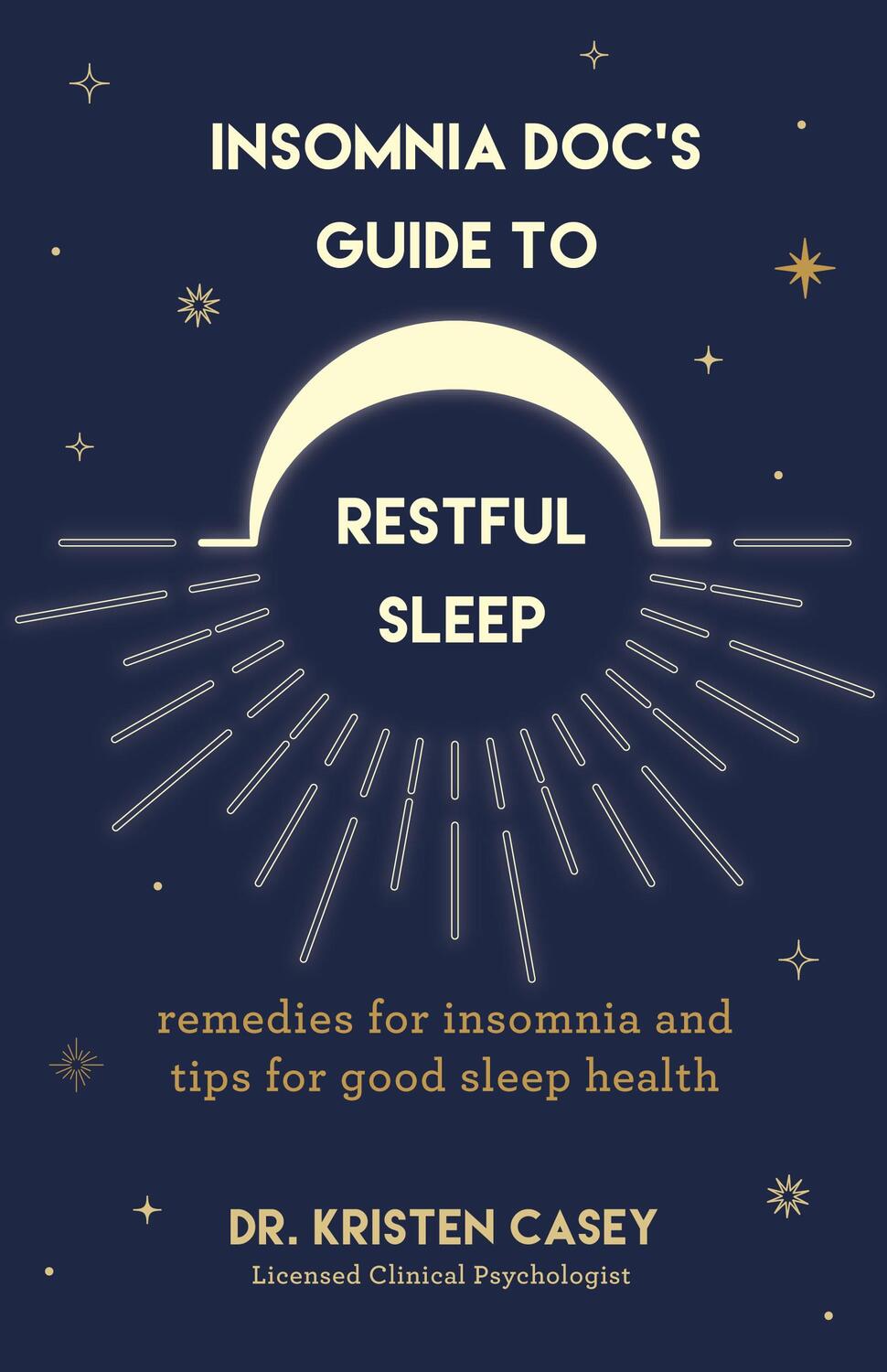Dekorationsartikel gehören nicht zum Leistungsumfang.
Sprache:
Englisch
21,15 €*
Versandkostenfrei per Post / DHL
Lieferzeit 1-2 Wochen
Kategorien:
Beschreibung
Exhausted parents have tried everything to get their children to sleep through the night so they can too. This book teaches parents to put their baby's needs ahead of his or her wants, explaining how to read the early signs of tiredness so children can be put to bed before they become overtired and start to fight sleep.
Exhausted parents have tried everything to get their children to sleep through the night so they can too. This book teaches parents to put their baby's needs ahead of his or her wants, explaining how to read the early signs of tiredness so children can be put to bed before they become overtired and start to fight sleep.
Über den Autor
Dr. Kennedy began her practice helping patients suffering from trauma-related sleep issues. In 2008 she created NYC Sleep Doctor, a consultation and psychotherapy practice dedicated to treating sleep difficulties in children and adults. Dr Kennedy runs clinics, sleep seminars and works with parents to help their children establish healthy sleep habits. She lives in New York with her husband and two children.
Inhaltsverzeichnis
- 1: Introduction
- 1: The Good Sleeper Approach to Infant Sleep
- 1: It's All About Adrenaline
- 1: Adrenaline and Overfatigue
- 2: Keeping Your Baby Well Rested
- 1: Watching the Clock
- 2: Following Drowsiness Cues
- 3: Common Myths and Misconceptions
- 4: Key Points from Chapter
- 2: The Early Weeks (0-6 Weeks Old)
- 1: Where Will Your Baby Sleep?
- 1: A Hierarchy of Sleep Independence
- 2: Becoming Your Baby's Sleep Facilitator
- 1: Responding to Drowsiness Cues
- 2: White Noise
- 3: Responding to Night Waking
- 4: Dummies
- 3: The Onset of Fussiness
- 1: Coping with Colic
- 2: Is It Reflux?
- 4: Avoid Information Overload
- 5: Key Points from Chapter
- 3: The Light at the End of the
- 1: Newborn Tunnel (6-12 Weeks)
- 2: The Beginnings of the Body Clock
- 3: The Sleep and Eating "Schedule"
- 4: The Sleep Environment
- 5: Easing into Independent Napping
- 6: Establishing the Bedtime Routine
- 7: Lengthening Night Sleep
- 8: Baby Monitors
- 9: Transitioning to the Cot
- 10: Dummies
- 11: Swaddles
- 12: Challenging Situations: Colic and Reflux
- 13: Key Points from Chapter 3
- 4: A Schedule Emerges (12-20 Weeks and Beyond)
- 1: Toning Down the Soothing
- 2: The Schedule Develops
- 3: Why So Much Focus on Naps?
- 4: The Early Bedtime
- 5: The Schedule Evolves
- 1: What If You Don't Have a Choice About Nap Times?
- 6: Key Points from Chapter 4
- 5: Sleeping Through the Night
- 1: Step 1: Get Your Baby as Rested as Possible
- 2: Step 2: Create Sleep Cues and Stop Feeding to Sleep
- 3: Step 3: Teach Your Baby to Fall Asleep in the Cot
- 4: Step 4: Figure Out Why Your Baby Is Still Waking Up
- 1: Need Versus Want
- 5: Step 5: Pick a Strategy: Methodical Step-by Step or Cut to the Chase
- 6: Step 6: Weaning from Night Feedings
- 7: Step 7: Weaning from Night Soothing
- 8: Step 8: The Final Hurdle: Cry-It-Out
- 1: Timing
- 2: Extinction Explained
- 3: Preparation and Safety
- 4: The Process
- 5: Crying with Checks: AKA the
- 6: "Ferber Method"
- 7: Crying Without Checks
- 8: Keeping a Scheduled Feeding
- 9: Dream Feeding
- 10: Vomit
- 11: How to Survive Cry-It-Out
- 12: Your Baby's Reaction
- 13: How Long Does It Take?
- 14: Does It Last?
- 9: Key Points from Chapter 5
- 6: Getting Unstuck
- 1: Your Self-Assessment
- 2: Determining Your Plan of Action
- 3: Working in Phases
- 1: Phase 1: Laying the Groundwork
- 2: Phase 2: It's Time for Crying
- 4: Nights, Naps, or Both?
- 5: How to Use Crying at Nap Time
- 6: What If Crying Doesn't Work?
- 7: Key Points from Chapter 6
- 7: Tricky Circumstances
- 1: Space Challenges
- 2: Siblings
- 3: Room Sharing
- 4: Travel
- 5: Jet Lag
- 6: Daylight Savings
- 7: Changes and Derailments
- 1: Illness
- 2: Teething
- 3: Developmental Milestones
- 8: Developmental Changes to the Sleep Schedule
- 9: Key Points from Chapter 7
- 8: Child Care
- 1: Day Care or Nanny?
- 2: Benefits of Day Care
- 3: Disadvantages of Day Care
- 4: Benefits of Hiring a Nanny
- 5: Disadvantages of Hiring a Nanny
- 6: What to Look For in a Day Care
- 7: Talking to Your Nanny About Sleep
- 8: And Now, Take the Leap
- 9: Key Points from Chapter 8
- 9: Reality Check
- 1: You Can't Control Everything
- 2: You Do Need to Have Some Control
- 3: Sleep Is Not Always Perfectly Predictable
- 4: Good Sleepers Make Noise During the Night
- 5: Taking a Step Back
- 6: Key Points from Chapter 9
- 10: When the Baby Is Sleeping but the Parents Aren't
- 1: Having a Baby Is Stressful, Even When Things Go Smoothly
- 2: Taking Care of Yourself in Increments
- 3: Getting the Sleep You Need
- 4: Resetting Your Body Clock
- 5: Take Care of You
- 11: Appendix A: Cry-It-Out: Is It Harmful?
- 1: "Scientists Say . . ."
- 2: What the Leading Scientists Really Say
- 1: Research on Cry-It-Out/Extinction
- 2: The Impact of Sleep Training on Attachment
- 3: The Truth About Cortisol
- 4: What About Long-term Effects of Cry-It-Out?
- 12: Appendix B: The Good Sleeper Primer
- 13: Appendix C: Sleep Diaries
- 14: Index of Case Examples
- 15: Recommended Reading and Viewing
- 16: References from Appendix A: Cry-It-Out: Is It Harmful?
- 17: Additional Sources
- 18: Acknowledgments
- 19: Index
Details
| Erscheinungsjahr: | 2015 |
|---|---|
| Fachbereich: | Erziehungsratgeber |
| Genre: | Erziehung & Bildung |
| Rubrik: | Sozialwissenschaften |
| Medium: | Taschenbuch |
| Seiten: | 304 |
| Inhalt: | Kartoniert / Broschiert |
| ISBN-13: | 9780091954895 |
| ISBN-10: | 0091954894 |
| Sprache: | Englisch |
| Einband: | Kartoniert / Broschiert |
| Autor: | Kennedy, Janet |
| Hersteller: | Ebury Publishing |
| Maße: | 216 x 137 x 25 mm |
| Von/Mit: | Janet Kennedy |
| Erscheinungsdatum: | 29.01.2015 |
| Gewicht: | 0,329 kg |
Über den Autor
Dr. Kennedy began her practice helping patients suffering from trauma-related sleep issues. In 2008 she created NYC Sleep Doctor, a consultation and psychotherapy practice dedicated to treating sleep difficulties in children and adults. Dr Kennedy runs clinics, sleep seminars and works with parents to help their children establish healthy sleep habits. She lives in New York with her husband and two children.
Inhaltsverzeichnis
- 1: Introduction
- 1: The Good Sleeper Approach to Infant Sleep
- 1: It's All About Adrenaline
- 1: Adrenaline and Overfatigue
- 2: Keeping Your Baby Well Rested
- 1: Watching the Clock
- 2: Following Drowsiness Cues
- 3: Common Myths and Misconceptions
- 4: Key Points from Chapter
- 2: The Early Weeks (0-6 Weeks Old)
- 1: Where Will Your Baby Sleep?
- 1: A Hierarchy of Sleep Independence
- 2: Becoming Your Baby's Sleep Facilitator
- 1: Responding to Drowsiness Cues
- 2: White Noise
- 3: Responding to Night Waking
- 4: Dummies
- 3: The Onset of Fussiness
- 1: Coping with Colic
- 2: Is It Reflux?
- 4: Avoid Information Overload
- 5: Key Points from Chapter
- 3: The Light at the End of the
- 1: Newborn Tunnel (6-12 Weeks)
- 2: The Beginnings of the Body Clock
- 3: The Sleep and Eating "Schedule"
- 4: The Sleep Environment
- 5: Easing into Independent Napping
- 6: Establishing the Bedtime Routine
- 7: Lengthening Night Sleep
- 8: Baby Monitors
- 9: Transitioning to the Cot
- 10: Dummies
- 11: Swaddles
- 12: Challenging Situations: Colic and Reflux
- 13: Key Points from Chapter 3
- 4: A Schedule Emerges (12-20 Weeks and Beyond)
- 1: Toning Down the Soothing
- 2: The Schedule Develops
- 3: Why So Much Focus on Naps?
- 4: The Early Bedtime
- 5: The Schedule Evolves
- 1: What If You Don't Have a Choice About Nap Times?
- 6: Key Points from Chapter 4
- 5: Sleeping Through the Night
- 1: Step 1: Get Your Baby as Rested as Possible
- 2: Step 2: Create Sleep Cues and Stop Feeding to Sleep
- 3: Step 3: Teach Your Baby to Fall Asleep in the Cot
- 4: Step 4: Figure Out Why Your Baby Is Still Waking Up
- 1: Need Versus Want
- 5: Step 5: Pick a Strategy: Methodical Step-by Step or Cut to the Chase
- 6: Step 6: Weaning from Night Feedings
- 7: Step 7: Weaning from Night Soothing
- 8: Step 8: The Final Hurdle: Cry-It-Out
- 1: Timing
- 2: Extinction Explained
- 3: Preparation and Safety
- 4: The Process
- 5: Crying with Checks: AKA the
- 6: "Ferber Method"
- 7: Crying Without Checks
- 8: Keeping a Scheduled Feeding
- 9: Dream Feeding
- 10: Vomit
- 11: How to Survive Cry-It-Out
- 12: Your Baby's Reaction
- 13: How Long Does It Take?
- 14: Does It Last?
- 9: Key Points from Chapter 5
- 6: Getting Unstuck
- 1: Your Self-Assessment
- 2: Determining Your Plan of Action
- 3: Working in Phases
- 1: Phase 1: Laying the Groundwork
- 2: Phase 2: It's Time for Crying
- 4: Nights, Naps, or Both?
- 5: How to Use Crying at Nap Time
- 6: What If Crying Doesn't Work?
- 7: Key Points from Chapter 6
- 7: Tricky Circumstances
- 1: Space Challenges
- 2: Siblings
- 3: Room Sharing
- 4: Travel
- 5: Jet Lag
- 6: Daylight Savings
- 7: Changes and Derailments
- 1: Illness
- 2: Teething
- 3: Developmental Milestones
- 8: Developmental Changes to the Sleep Schedule
- 9: Key Points from Chapter 7
- 8: Child Care
- 1: Day Care or Nanny?
- 2: Benefits of Day Care
- 3: Disadvantages of Day Care
- 4: Benefits of Hiring a Nanny
- 5: Disadvantages of Hiring a Nanny
- 6: What to Look For in a Day Care
- 7: Talking to Your Nanny About Sleep
- 8: And Now, Take the Leap
- 9: Key Points from Chapter 8
- 9: Reality Check
- 1: You Can't Control Everything
- 2: You Do Need to Have Some Control
- 3: Sleep Is Not Always Perfectly Predictable
- 4: Good Sleepers Make Noise During the Night
- 5: Taking a Step Back
- 6: Key Points from Chapter 9
- 10: When the Baby Is Sleeping but the Parents Aren't
- 1: Having a Baby Is Stressful, Even When Things Go Smoothly
- 2: Taking Care of Yourself in Increments
- 3: Getting the Sleep You Need
- 4: Resetting Your Body Clock
- 5: Take Care of You
- 11: Appendix A: Cry-It-Out: Is It Harmful?
- 1: "Scientists Say . . ."
- 2: What the Leading Scientists Really Say
- 1: Research on Cry-It-Out/Extinction
- 2: The Impact of Sleep Training on Attachment
- 3: The Truth About Cortisol
- 4: What About Long-term Effects of Cry-It-Out?
- 12: Appendix B: The Good Sleeper Primer
- 13: Appendix C: Sleep Diaries
- 14: Index of Case Examples
- 15: Recommended Reading and Viewing
- 16: References from Appendix A: Cry-It-Out: Is It Harmful?
- 17: Additional Sources
- 18: Acknowledgments
- 19: Index
Details
| Erscheinungsjahr: | 2015 |
|---|---|
| Fachbereich: | Erziehungsratgeber |
| Genre: | Erziehung & Bildung |
| Rubrik: | Sozialwissenschaften |
| Medium: | Taschenbuch |
| Seiten: | 304 |
| Inhalt: | Kartoniert / Broschiert |
| ISBN-13: | 9780091954895 |
| ISBN-10: | 0091954894 |
| Sprache: | Englisch |
| Einband: | Kartoniert / Broschiert |
| Autor: | Kennedy, Janet |
| Hersteller: | Ebury Publishing |
| Maße: | 216 x 137 x 25 mm |
| Von/Mit: | Janet Kennedy |
| Erscheinungsdatum: | 29.01.2015 |
| Gewicht: | 0,329 kg |
Warnhinweis










